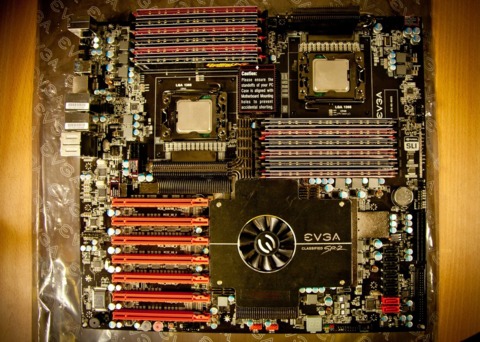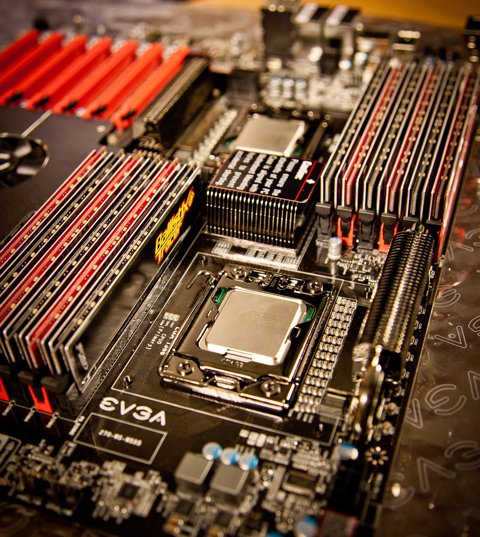Greatest Gaming Rig Part Two - EVGA SR-2, Intel X5680, Crucial Ballistix
We load our motherboard with RAM and processors for an eagerly anticipated boot test.
In part one of Greatest Gaming Rig, we took a look at what components we’d be featuring in the machine, as well as the accessories we’d be pairing with it. Now that we’ve got our grubby mitts on all the different bits and pieces, we’re ready to start building our behemoth. This week, we’re taking a closer look at the motherboard, RAM, and processors we’re going to use.
Metaphor: ReFantazio The King’s Trial Trailer Tales of the Shire - Official Announcement Trailer Dead Island 2 – Steam Launch Trailer Nickelodeon All-Star Brawl 2 - Official Zuko Gameplay Spotlight Trailer Valheim: Ashlands - Official Gameplay Trailer Tales of Kenzera: ZAU GameSpot Video Review Stellar Blade - Beta Skills Gameplay Trailer | PS5 Games Stellar Blade - Burst Skills Gameplay Trailer | PS5 Games GODDESS OF VICTORY: NIKKE | New Main Chapter 29~30 Update Trailer GODDESS OF VICTORY: NIKKE | Happy 1.5 Anniversary Trailer GODDESS OF VICTORY: NIKKE | Kilo Character Motion Demonstration Trailer How The Fallout TV Show Shapes Fallout's Future
Please enter your date of birth to view this video
By clicking 'enter', you agree to GameSpot's
Terms of Use and Privacy Policy
The EVGA SR-2 is an absolute monster of a motherboard. Not only does it support some of the latest desktop standards, such as SATA III and USB 3.0, but it also features a multitude of enthusiast-friendly features, which are capable of pushing components to the limit. It supports up to 48GB of DDR3-1600 RAM across 12 DIMM sockets; has two CPU sockets for dual Xeon processors; six SATA 3Gbps ports; two SATA 6Gbps ports; two eSATA sockets; 10 USB 2 ports; two USB 3 ports; two gigbit LAN sockets; and built-in 7.1 surround. However, its most unique feature is its seven PCIe slots, four of which can act as true 16X speed slots in parallel. This is different from most motherboards with several PCIe slots, which drop the speed of PCIe lanes to 8X when multiple cards are installed. The SR-2 accomplishes this feat by including two Nvidia Nforce 200 PCIe bridges, giving it a total of 64 PCIe v2 lanes--double that of most boards.
Overclockers are well catered for, with a number of features specifically designed for test-bench work without a case. There’s a row of voltage-monitoring points along the front edge of the PCB, allowing you to check voltages with a multimeter, a POST code display for boot diagnostics, and onboard power and reset buttons. There are also two CMOS reset buttons, as well as a BIOS switch. This allows you to load the board up with multiple BIOSs, so if you accidentally brick the board with some foolhardy tinkering, you can simply switch to backup and move forward.
Because the SR-2 has so many features, it really ups the stakes in power requirements. Each CPU socket has its own 8-pin power connector, as well as an optional 6-pin PCIe connection, so you have plenty of juice for pushing the clock speed when overclocking. There is also an additional 6-pin PCIe near the expansion slots, which is required when using multiple graphics cards. This makes it tricky to find power supplies that can actually power the board, as most aren’t supplied with enough power connectors to plug onto it, even if they can push enough voltage.
Of course, with so many features, the SR-2 isn’t exactly small. At 13.5 inches long and 15 inches wide, it’s one of the biggest motherboards available on the market. It’s so big in fact, that it only fits in a handful of cases without serious modification. EVGA has tried to get more manufacturers on board by giving the board a new form factor name, known as HPTX, though we can’t see many other chipset makers making boards of this size any time soon. However, none of this matters once you see the board in person--it is truly a thing of beauty. The sheer number of slots, capacitors, and buttons make it an awe-inspiring sight, and the red-and-black color scheme just adds to the wow factor. Also impressive are the number of high-quality heatsinks already installed, underneath which live the Intel 5520 chipset, Intel ICH10R Southbridge, and two Nvidia nForce 2 PCI-E controllers, all cooled by a single 60mm fan.

Slotting into our motherboard are Intel’s X5680 Xeon processors, which are at the top of their product range, a fact reflected in their £1250 price tag. They’re based on the Gulftown family of chips, which feature a 3.33Ghz clock speed, a 32 nanometer design, 12MB of L3 cache, and six cores with hyperthreading, allowing for 12 processing threads to run simultaneously. They also feature dual QPI links, which allow two processors to be used in the same system; something that can’t be done with Core i7 chips. The X5680s are intended to be used in servers and top-of-the-line workstations, often for rendering programs, medical research, and 3D design. They might be overkill for gaming, but they should ensure that our rig will be able to handle everything we throw at it.
For memory, we’re using unbuffered DDR3 RAM from Crucial’s Ballistix range. They’re 240 pin modules that run at on 1.8v at 1600Mhz, have an integrated aluminum heat spreader, and feature embedded LEDs, which light up when the RAM is accessed. The spreaders are also available in a variety of colors, with matching LEDs, so the style conscious can ensure their case is color coordinated. Though the EVGA SR-2 supports fully buffered RAM, we’re using unbuffered RAM due to its slightly better performance.
Check back here next week when we take a look at graphics cards and storage; we'll also go for a test boot to see if the kit plays nicely together. Don’t forget we’re giving you the chance to win the entire rig*, complete with accessories! Just head over here to find out more.
* To enter you have to be over 13 and a UK resident; the competition is subject to our normal terms and conditions.
Got a news tip or want to contact us directly? Email news@gamespot.com



Join the conversation